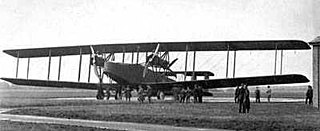
The Handley Page V/1500 was a British night-flying heavy bomber built by Handley Page towards the end of the First World War. It was a large four-engined biplane, which resembled a larger version of Handley Page's earlier O/100 and O/400 bombers, intended to bomb Berlin from East Anglian airfields. The end of the war stopped the V/1500 being used against Germany, but a single aircraft was used to carry out the first flight from England to India, and later carried out a bombing raid on Kabul during the Third Anglo-Afghan War. It was colloquially known within the fledgling Royal Air Force as the "Super Handley". The V/1500 which was shipped to Canada to attempt a transatlantic flight was flown in the US, and in 1919 crash-landed in a field at Mount Jewett, Pennsylvania. Photos appeared in the 20 February 1969 issue of the Bradford Journal newspaper.

The Handley Page Heyford was a twin-engine biplane bomber designed and produced by the British aircraft manufacturer Handley Page. It holds the distinction of being the last biplane heavy bomber to be operated by the Royal Air Force (RAF).
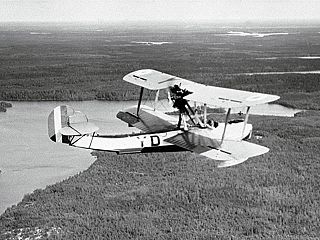
The Canadian Vickers Vedette was the first aircraft designed and built in Canada to meet a specification for Canadian conditions. It was a single-engine biplane flying boat purchased to meet a Royal Canadian Air Force (RCAF) demand for a smaller aircraft than the Vickers Viking with a much greater rate of climb, to be suitable for forestry survey and fire protection work. The type went on to have a long and distinguished career in civil operations in Canada. Most of the topographical maps in use in Canada today are based on photos taken from these aircraft.

The Airco DH.11 Oxford was a British twin-engined biplane bomber which was designed to replace the earlier Airco DH.10 Amiens. It was designed to use the unsuccessful ABC Dragonfly engine and was abandoned after the first prototype was built.
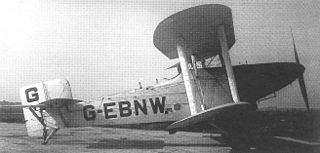
The Avro 571 Buffalo was a prototype British carrier-based torpedo bomber biplane, designed and built by Avro in the 1920s. It was not selected for service, the Blackburn Ripon being ordered instead.

The PZL.16 was a Polish passenger aircraft, designed in the early 1930s in the PZL in Warsaw. It remained a prototype.

The Handley Page H.P.24 Hyderabad was a twin-engine biplane heavy bomber designed and produced by the British aircraft manufacturer Handley Page. It holds the distinction of being the last wooden heavy bomber to be operated by the Royal Air Force (RAF).

The Bartel BM 5, initially known as M.5 was a Polish biplane advanced trainer used from 1930 to 1939 by the Polish Air Force, manufactured in the Samolot factory in Poznań.

The Häfeli DH-1 was a 1910s Swiss two-seat reconnaissance aircraft, built by the aircraft department of the Federal Construction Works at Thun, Switzerland.
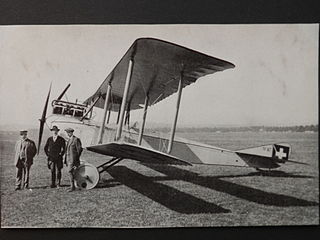
The Häfeli DH-2 was a 1910s Swiss two-seat reconnaissance aircraft, built by aircraft department of the Eidgenoessische Konstruktionswerkstaette at Thun, Switzerland.

The Häfeli DH-3 was a 1910 Swiss two-seat reconnaissance aircraft, built by the aircraft department of the Federal Construction Works at Thun, Switzerland.
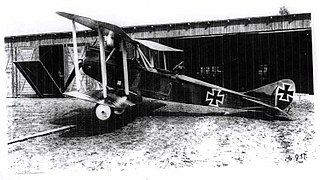
The Rumpler C.IV was a German single-engine, two-seat reconnaissance biplane. It was a development of C.III with different tail surfaces and using a Mercedes D.IVa engine in place of the C.III's Benz Bz.IV. The Rumpler 6B 2 was a single-seat floatplane fighter variant with a 120 kW (160 hp) Mercedes D.III engine built for the Kaiserliche Marine.

Entering service in 1915, the Rumpler C.I,, two-seater single-engine reconnaissance biplane, was one of the first German C-type aircraft, and also one of the longest serving in its class during World War I, being retired from the last front line units only in early 1918.
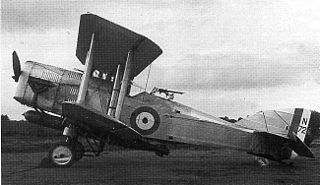
The Handley Page Hendon was a British torpedo bomber of the 1920s. A two-seat development of Handley Page's earlier single-seat Hanley, the Hendon was a single-engine biplane. While six aircraft were purchased by the British Air Ministry for evaluation and trials purposes, no further production ensued and the Hendon did not enter squadron service.
The Handley Page HP.14, also designated Handley Page R/200 was a prototype British naval reconnaissance aircraft of World War I, capable of operating from the decks of the Royal Navy's aircraft carriers or as a floatplane. Only three were built, the Parnall Panther being preferred.
The Häfeli DH-4 was a Swiss fighter prototype in the late 1910s, build by the Eidgenoessische Konstruktionswerkstaette. The DH-4 was a single-seat fighter based on the successful Häfeli DH-3 design. It was made of wood with fabric covering, and carried one machine gun.

The Argus As II was a six-cylinder, in-line, water-cooled, aircraft engine produced in Germany by Argus Motoren in 1914. The Argus As II produced 120 hp (89 kW) at 1,350 rpm.

The PWS-5 or PWS-5t2, was a multi-seated Polish liaison aircraft, developed in 1928 by PWS.

The Mikoyan-Gurevich I-220 was a prototype high-altitude fighter aircraft built in the Soviet Union during World War II. Originally developed to counter the threat of German high-altitude reconnaissance aircraft, a total of seven prototypes were built and tested across five variants. By 1944, the threat of German high-altitude aircraft had subsided, and production of the I-220 and its variants was seen as unnecessary.

The Otto C.I, also known as the Otto KD.15, was a German two-seat biplane reconnaissance and bomber aircraft of the First World War designed and produced by Otto Flugmaschinenfabrik. The C.I was a rare example of an aircraft flown by the Central Powers which had a pusher configuration.



















